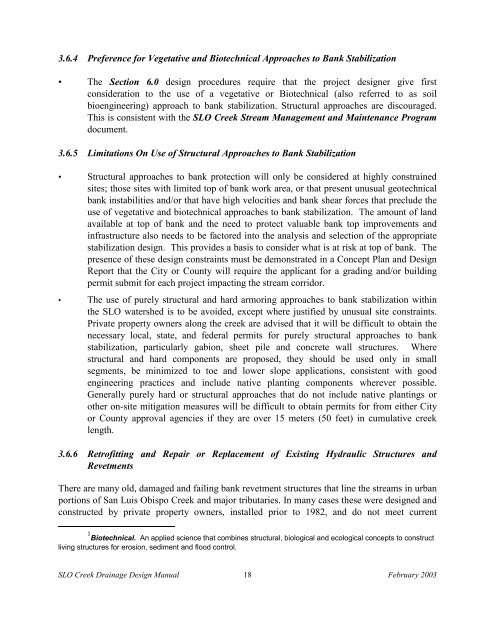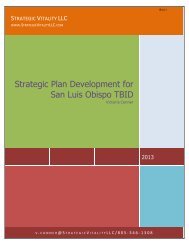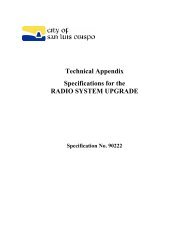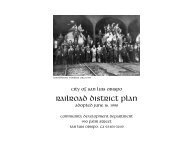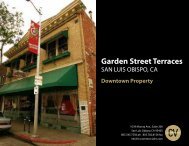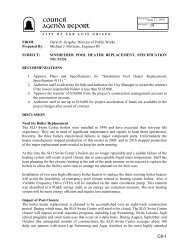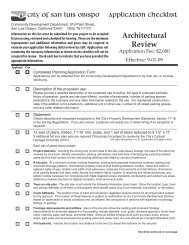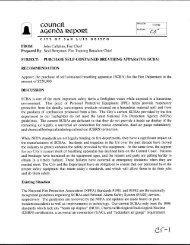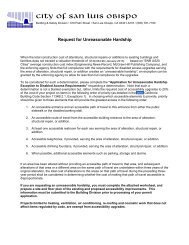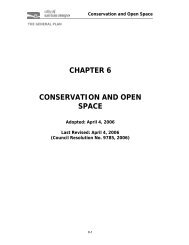Drainage Design Manual - the City of San Luis Obispo
Drainage Design Manual - the City of San Luis Obispo
Drainage Design Manual - the City of San Luis Obispo
You also want an ePaper? Increase the reach of your titles
YUMPU automatically turns print PDFs into web optimized ePapers that Google loves.
3.6.4 Preference for Vegetative and Biotechnical Approaches to Bank Stabilization• The Section 6.0 design procedures require that <strong>the</strong> project designer give firstconsideration to <strong>the</strong> use <strong>of</strong> a vegetative or Biotechnical (also referred to as soilbioengineering) approach to bank stabilization. Structural approaches are discouraged.This is consistent with <strong>the</strong> SLO Creek Stream Management and Maintenance Programdocument.3.6.5 Limitations On Use <strong>of</strong> Structural Approaches to Bank Stabilization• Structural approaches to bank protection will only be considered at highly constrainedsites; those sites with limited top <strong>of</strong> bank work area, or that present unusual geotechnicalbank instabilities and/or that have high velocities and bank shear forces that preclude <strong>the</strong>use <strong>of</strong> vegetative and biotechnical approaches to bank stabilization. The amount <strong>of</strong> landavailable at top <strong>of</strong> bank and <strong>the</strong> need to protect valuable bank top improvements andinfrastructure also needs to be factored into <strong>the</strong> analysis and selection <strong>of</strong> <strong>the</strong> appropriatestabilization design. This provides a basis to consider what is at risk at top <strong>of</strong> bank. Thepresence <strong>of</strong> <strong>the</strong>se design constraints must be demonstrated in a Concept Plan and <strong>Design</strong>Report that <strong>the</strong> <strong>City</strong> or County will require <strong>the</strong> applicant for a grading and/or buildingpermit submit for each project impacting <strong>the</strong> stream corridor.• The use <strong>of</strong> purely structural and hard armoring approaches to bank stabilization within<strong>the</strong> SLO watershed is to be avoided, except where justified by unusual site constraints.Private property owners along <strong>the</strong> creek are advised that it will be difficult to obtain <strong>the</strong>necessary local, state, and federal permits for purely structural approaches to bankstabilization, particularly gabion, sheet pile and concrete wall structures. Wherestructural and hard components are proposed, <strong>the</strong>y should be used only in smallsegments, be minimized to toe and lower slope applications, consistent with goodengineering practices and include native planting components wherever possible.Generally purely hard or structural approaches that do not include native plantings oro<strong>the</strong>r on-site mitigation measures will be difficult to obtain permits for from ei<strong>the</strong>r <strong>City</strong>or County approval agencies if <strong>the</strong>y are over 15 meters (50 feet) in cumulative creeklength.3.6.6 Retr<strong>of</strong>itting and Repair or Replacement <strong>of</strong> Existing Hydraulic Structures andRevetmentsThere are many old, damaged and failing bank revetment structures that line <strong>the</strong> streams in urbanportions <strong>of</strong> <strong>San</strong> <strong>Luis</strong> <strong>Obispo</strong> Creek and major tributaries. In many cases <strong>the</strong>se were designed andconstructed by private property owners, installed prior to 1982, and do not meet current1 Biotechnical. An applied science that combines structural, biological and ecological concepts to constructliving structures for erosion, sediment and flood control.SLO Creek <strong>Drainage</strong> <strong>Design</strong> <strong>Manual</strong> 18 February 2003


